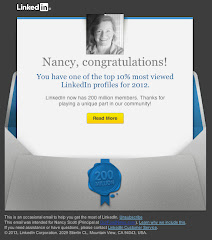Digitization is creating
a second – and relatively silent -- economy that’s vast, automatic, and
invisible. McKinsey Quarterly calls this the biggest change since the Industrial
Revolution. As an example of this second economy, Professor W. Brian Arthur contrasts a simple flying experience in 1990 to the digital frenzy accompanying every aspect of an airplane flight
today – registration, check in, luggage handling, security, etc. “So we can say that another economy—a
second economy—is silently forming alongside the
physical economy … This suggests to me that the main challenge of the economy
is shifting from producing prosperity to distributing prosperity.”
Takeaway: What revenue possibilities might be hiding in your organization's “second economy”?
Source: McKinsey Quarterly
6. The Marketplace Wants Ever Newer, Ever Fresher.
Trendwaching talks about “Newism” and employs attentive eyes and ears in 170 countries, all focused on spotting trends.
Takeaway: How might your organization employ its own “trendspotters”?
Source: Trendwatching Brief.
5. Re-imagine.
A few weeks ago,
I was trying to imagine what a home entertainment center might look like in three years. Of
course I “saw” wireless systems, image projection everywhere, and voice control.
But I didn't see any headphones. Surprise: A recent tweet from
@HomeTechDudes, reported on the new Microsoft patent
that imagines headphones as an accessory that docks everything to the mother ship. [Headphones?]
Takeaway: In the planning stage, imagine old systems in new ways.
4. Specializing Is the Newest Old Trick.
Nobody understands “targeted” better than marketers. Still, it’s still difficult to
grasp all the "niche niches" that digital can mine. Jess3 is a
case in point. Here’s a creative agency that specializes in data visualization
– meaning, these folks are expert at turning a complex idea into a single glance.
Takeaway: What current capability can you hone or craft into a unique product/service?
3. America Is
Getting Self-Employed.
Labor historian
Richard Greenwald believes that the American workplace is undergoing a shift
every bit as profound as our 19th century move from farms to
factories. The current trend, which Greenwald predicts will accelerate in coming
years, sees up to 50% of Americans self-employed as free agents, contractors,
day laborers, consultants, etc. “These
white-collar folks are workers. And, in the new economy, collar doesn't signify
class the way it once did," Greenwald says.
Takeaway: Reconsider the attributes and benefits of non-employee talent.
Source: HuffingtonPost, June 15.
2. Everybody Wants
Something To See.
I’ve been subscribing
to and following Natalie MacLean’s wine commentary since she went online a
decade ago. I remember her early-- and cutting edge--foray into electronic
newsletters. I’ve watched her successfully sell ebooks and master social media. MacLean has always been ahead of the marketing curve. No surprise,
then, that her website is full of lush photos and devotes a tab to “video.” Natalie’s
June and July blogs feature an online video interview with Rex Pickett, author
of Sideways (from which we all learned
to declare, “I’m not drinkin’ any •••••• merlot.”).
Takeaway: What photos, graphics, and video can
your organization affordably gather to capture eyeballs?
Source: Natalie MacLean's blog.
1. Saying “No” Is
Smart.
Greg McKeown writes
for the Harvard Business Review. On April 30, he cited “one thing CEOs need to
learn from Apple.” Pointing to Steve Jobs approach, McKeown makes the
case for culling, paring down, and throwing out. “Jobs cut out profitable business
lines at a time when the company appeared it could least afford to do so,
culling the business down to four clear product lines.” McKeown concludes with this advice: “So next time you’re leading an offsite strategy session,
don’t be satisfied with a list of priorities that you’re going to say ‘yes’ to.
Go through the process of answering the essential strategy question: 'What will
we say no to?' That question will reveal the
real tensions in your team. It is that question that will uncover the core
trade-offs in your organization. It is that question that can deliver the rare
and precious clarity necessary to achieve game-changing breakthroughs in your
business.”
Takeaway: Read
McKeown’s advice again.



